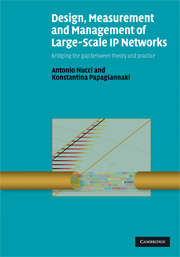 Design, Measurement and Management of Large-Scale IP Networks
Design, Measurement and Management of Large-Scale IP Networks Book contents
- Frontmatter
- Contents
- Acknowledgments
- 1 Introduction
- 2 Background and context
- I Network monitoring and management
- II Network design and traffic engineering
- III From bits to services
- Appendix A How to link original and measured flow characteristics when packet sampling is used: bytes, packets and flows
- Appendix B Application-specific payload bit strings
- Appendix C BLINC implementation details
- Appendix D Validation of direction-conforming rule
- References
- Index
2 - Background and context
Published online by Cambridge University Press: 05 September 2012
- Frontmatter
- Contents
- Acknowledgments
- 1 Introduction
- 2 Background and context
- I Network monitoring and management
- II Network design and traffic engineering
- III From bits to services
- Appendix A How to link original and measured flow characteristics when packet sampling is used: bytes, packets and flows
- Appendix B Application-specific payload bit strings
- Appendix C BLINC implementation details
- Appendix D Validation of direction-conforming rule
- References
- Index
Summary
Before embarking on the exploration of techniques to assist operators in the management and design of IP networks, this chapter lays the foundation of the terms and concepts that will be used in the rest of the book. We describe the Internet architecture and the elements and protocols guiding its behavior. We then outline issues associated with the design, management, optimization and security of such a complex infrastructure, topics that will be the focal points in the following chapters.
What is the Internet?
The Internet is a diverse collection of independent networks, interlinked to provide its users with the appearance of a single, uniform network. Two factors shield the user from the complex realities that lie behind the illusion of seamlessness: (i) the use of a standard set of protocols to communicate across networks and (ii) the efforts of the companies and organizations that operate the Internet's different networks to keep its elements interconnected.
The networks that comprise the Internet share a common architecture (how the components of the networks inter-relate) and software protocols (standards governing the exchange of data), which enable communication within and among the constituent networks. The nature of these two abstract elements – architecture and protocols – is driven by the set of fundamental design principles adopted by the early builders of the Internet. It is important to distinguish between the public Internet and the Internet's core technology (standard protocols and routers), which are frequently called “IP technology.”
- Type
- Chapter
- Information
- Design, Measurement and Management of Large-Scale IP NetworksBridging the Gap Between Theory and Practice, pp. 5 - 22Publisher: Cambridge University PressPrint publication year: 2008
